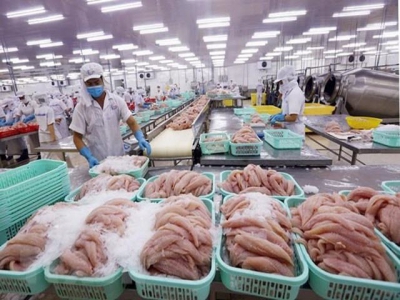Seafood exports to China on the mend

Hanoi – Vietnam’s seafood exports to China are expected to rise in the second half of this year to reach the 1.2 billion USD target for the whole of this year as China’s seafood demand is on the rise, and the escalating US-China trade tension is likely to create as an opportunity for Vietnamese exporters to increase their market share in China.
Tra fish processed for exports (Photo: VNA)
The Southeast Asian country saw the value of its seafood exports to China fall during January-June, owing to tightened inspections by Chinese authorities. In the six-month period, shipments dwindled 2.3 percent to 572 million USD, of which value gained from shrimp exports decreased nearly 5 percent. Meanwhile, the export revenue of tra fish and tuna rose 2 percent and 183 percent, respectively.
According to General Secretary of the Vietnam Association of Seafood Exporters and Producers (VASEP) Truong Dinh Hoe, Chinese customs has tighten the trading of seafood products via unofficial channels, and enhanced inspections for those passing through official channels since May 1 when it took the charge of food safety management for imported products.
In the meantime, many small businesses were lacking the information, and were not well-prepared for the ban on exports via unofficial channels.
Authorities of both nations have already agreed that seafood exported to China must be produced by companies that are certified by Vietnam’s National Agro-Forestry-Fisheries Quality Assurance Department (Nafiqad). Besides, Vietnamese exporters must present a letter of certification on food safety granted by the Nafiqad for their batches.
The Nafiqad and the Chinese General Administration of Customs update and inform each other about qualified producers and exporters. The Chinese customs also demands that Vietnamese seafood must be in the list of 120 species which are allowed to be exported to China.
Furthermore, to enter the Chinese market, exporters must show quarantine certificates, certificates of origin, and packaging information in both English and Chinese as well as in line with China’s standards.
Several seafood exporters did not have a deep insight into the requirements, that is why their products failed to break into the market. The VASEP said Vietnamese fishermen have suffered a lot as their dried squid products have not been allowed to be sold to China via official channels.
To break the deadlock, besides understanding China’s import regulations, Vietnamese businesses should improve production facilities, better food safety and hygiene so that their seafood products are eligible to penetrate into the Chinese market, Hoe pointed out, stressing shipments via official channels must be prioritised to avoid risks in payments as well as cargos’ quality.
Even if producers are able to enter the market, they will face tough seas ahead. The higher speed of devaluation of the Chinese yuan than the Vietnamese dong against the US dollar is another challenge for the Vietnamese seafood sector as it will make made-in-Vietnam products become more expensive than those produced in rival nations like India and Ecuador.
Besides, Chinese consumers have preferred high-quality products that meet standards of others choosy markets like the US, the EU and Japan.
Therefore, many experts said it is hard for Vietnamese exporters to reverse their exports to the market in short term
Related news
 New method documents feed nutrient utilization
New method documents feed nutrient utilization Feed efficiency may be individually assessed in fish without recording individual feed intakes.
 Risk management for the aquaculture industry
Risk management for the aquaculture industry The last five years alone have seen the aquaculture industry face unprecedented loss events from widespread algal blooms, novel disease outbreaks
 Shrimp exports expected to pick up in 2nd half
Shrimp exports expected to pick up in 2nd half Việt Nam’s shrimp exports are expected to be strong during the rest of this year because countries tend to import more in the latter months of the year